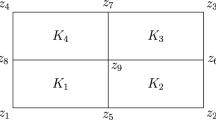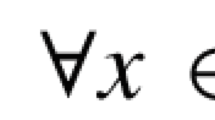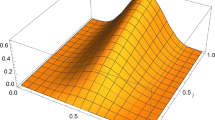Abstract
This paper is concerned with the dissipativity of Runge-Kutta methods for a class of nonlinear functional-integro-differential equations (FIDEs). The dissipativity results of Runge-Kutta methods for the FIDEs are given. It is shown under a suitable condition that an algebraically stable Runge-Kutta method is dissipative when applied to the FIDEs. Numerical examples are given to illustrate the correctness of our theoretical results.
Similar content being viewed by others
1 Introduction
Among various properties of dynamical systems, dissipativity is one of important characteristics. A dissipative dynamical system is characterized by possessing a bounded absorbing set that all trajectories enter in a finite time and thereafter remain inside [1]. In the study of numerical methods for these systems, one natural wish is for the numerical solution to preserve the dissipativity of the analytic solution.
Over the past few decades, the dissipativity of the analytic solution and numerical methods for some special class dynamical systems of VFDEs have been studied widely. One can refer to the following works and corresponding authors: [2–5] for ordinary differential equations (ODEs), [6–10] for delay differential equations (DDEs), and [11–20] for other kinds of Volterra functional differential equations, such as delay integro-differential equations (DIDEs), neutral delay differential equations (NDDEs), neutral delay integro-differential equations (NDIDEs) and so on.
In this paper, we investigate numerical dissipativity of a class of nonlinear functional-integro-differential equations (FIDEs) (see (2.1) in the next section). In 2014 and 2015, Zhang and Qin studied the stability of Runge-Kutta methods [21] and one-leg methods [22] for this kind of problems, respectively. Recently, we also studied the dissipativity of systems (2.1) and of one-leg methods for FIDEs (2.1) [23]. In addition we do not find more dissipativity results for this kind of nonlinear FIDEs. The aim of this paper is to investigate the dissipativity of Runge-Kutta methods for (2.1).
This paper is organized as follows. In Section 2, the descriptions of the nonlinear FIDEs and their Runge-Kutta methods are given. In Section 3, the results on the dissipativity of Runge-Kutta methods are deduced. In Section 4, some numerical experiments are given to illustrate the theoretical results which we stated in previous sections.
2 The descriptions of problem class and numerical methods
Let \({\mathbb {C}}^{d}\) be a d-dimensional complex Euclidean space with the inner product \(\langle\cdot,\cdot\rangle\) and the corresponding norm \(\| \cdot\|\). For any nonnegative diagonal matrix \(B=\operatorname{diag}(b_{1},b_{2},\ldots,b_{s})\), we define a pseudo inner product on \(\mathbb{C}^{ds}:=(\mathbb{C}^{d})^{s}\) by
and the corresponding pseudo norm on \(\mathbb{C}^{ds}\) by
It is obvious that when B is positive definite, they are the inner product and the norm on \(\mathbb{C}^{ds}\), respectively.
Consider nonlinear functional integro-differential equations (FIDEs) of the form (cf. [21, 22])
where \(\tau>0\) is a given constant delay, the functions \(f:[t_{0},+\infty)\times{\mathbb{C}^{d}}\times{\mathbb{C}^{d}}\rightarrow \mathbb{C}^{d}\), \(g:\mathbb{D}\times\mathbb{C}^{d} \rightarrow\mathbb{C}^{d}\), and \(\varphi:[t_{0}-\tau,t_{0}]\rightarrow\mathbb{C}^{d}\) are assumed to be continuous so that system (2.1) has a unique solution \(x(t)\), and f and g satisfy also the conditions
and
where γ, α, β, η, λ are given real constants and γ, −α, β, η are nonnegative, and \(\lambda>0\) with \(2\lambda\tau<1\),
In order to investigate the numerical dissipativity of (2.1), we assume further that f satisfies the condition: for any constant \(M>0\), there exists \(L>0\) which is only dependent on M such that \(\| f(t,u,v)\|\leq L\) holds for any \(t\geq t_{0}\), \(\| u\|\leq M\) and \(\| v\|\leq M\).
Definition 2.1
cf. [13]
Problem (2.1) in FIDEs is said to be dissipative in \(\mathbb{C}^{d}\) if there exists a bounded set \(B\subset\mathbb{C}^{d}\) such that for any given bounded set \(\Phi\subset\mathbb{C}^{d}\), there is a time \(t^{*}=t^{*}(\Phi)\) such that for any given continuous initial function \(\varphi:[t_{0}-\tau, t_{0} ]\rightarrow\mathbb{C}^{d}\) with \(\varphi(t)\) contained in Φ for all \(t\in[t_{0}-\tau, t_{0}]\), the corresponding solution \(x(t)\) of the problem is contained in B for all \(t\geq t^{*}\). Here B is called an absorbing set in \(\mathbb{C}^{d}\).
In our recent paper [23], we studied the dissipativity of (2.1) and gave the following results.
Theorem 2.2
Suppose that \(x(t)\) is a solution of problem (2.1) where f and g satisfy (2.2) with \(\alpha<0\) and (2.3), respectively, and there exists constant \(0<\delta<1\) such that
Then,
-
(i)
for any \(t \geq t_{0}\), we have
$$\bigl\Vert x(t) \bigr\Vert ^{2}\leq\frac{4}{1-2\lambda^{2}\tau^{2}} \frac {-\gamma}{(1-\delta)\alpha}+ \frac{1-2\lambda^{2}\tau^{2}}{1-2\lambda^{2}\tau^{2}e^{\bar{\mu}\tau }}\phi e^{-\bar{\mu}(t-t_{0})}, $$where \(\phi=\sup_{t_{0}-\tau\leq\xi\leq t_{0}} \|\varphi (\xi)\|^{2}\), and \(\bar{\mu}>0\) is defined as
$$\bar{\mu}=\inf_{t\geq t_{0}} \biggl\{ \mu(t):\mu(t)+\alpha+\bigl(\beta +(\eta-\alpha) \lambda^{2}\tau^{2}\bigr) \frac{4e^{\mu(t)\tau}}{1-2\lambda ^{2}\tau^{2}e^{\mu(t)\tau}}=0 \biggr\} ; $$here and later, the symbols γ, α, β, η, λ are given by (2.2) and (2.3);
-
(ii)
for any given \(\varepsilon>0 \), there exists \(t^{*}=t^{*}(\phi, \varepsilon)\) such that
$$\bigl\Vert x(t) \bigr\Vert ^{2}\leq\frac{4}{1-2\lambda^{2}\tau^{2}} \frac {-\gamma}{(1-\delta)\alpha}+\varepsilon, \quad t\geq t^{*}. $$
Hence system (2.1) is dissipative with an absorbing set
Remark 2.3
In [21] and [22], the authors studied the stability of Runge-Kutta methods and one-leg methods for FIDEs (2.1) on a limited closed interval \([0,T]\), but the monotonicity condition
is required. There exist some important differences between conditions (2.2) and (2.5). In fact, as an example without delay and integral terms, Humphries and Stuart [2] proved that after translation of the origin, the Lorenz equations are dissipative, but do not satisfy condition (2.5). In addition, the dissipativity is a long time characteristic of a system rather than the stability on a limited closed interval.
The aim of this paper is to investigate whether the Runge-Kutta methods for system (2.1) preserve the dissipativity of the system itself.
It is well known that an s-stage Runge-Kutta method for ODEs can be expressed as
where \(A=(a_{ij})\in\mathbb{R}^{s\times s}, b=(b_{1},b_{2},\ldots ,b_{s})^{T}\in\mathbb{R}^{s}\) and \(c=(c_{1},c_{2},\ldots,c_{s})^{T}\in\mathbb{R}^{s}\) with \(0\leq c_{i}\leq1\) (\(i=1,2,\ldots,s\)) and \(\sum_{j=1}^{s}b_{j}=1\).
The following algebraic stability concept is the basis for studying the dissipativity of Runge-Kutta methods.
Definition 2.4
Runge-Kutta method (2.6) is said to be algebraically stable if
are nonnegative definite.
Let the step size \(h=\frac{\tau}{m}\) with some positive integer m and \(t_{n}=t_{0}+nh\). An adaptation of method (2.6) for solving problem (2.1) leads to (see [22])
where \(x_{n}\), \(X_{i}^{(n)}\) denote approximations to \(x(t_{n})\), \(x(t_{n}+c_{i}h)\) and \(z_{n}\) and \(Z_{i}^{(n)}\) approximations to \(z(t_{n})\) and \(z(t_{n}+c_{i}h)\), respectively. Here and later, we put that
In addition,
As to the computation of integral terms \(z_{n}\), \(Z_{i}^{(n)}\), we apply the compound quadrature formulas
where the quadrature formulas (2.10) and (2.11) can be derived from a uniform repeated rule (cf. [13, 21, 22]). For the numerical dissipativity analysis, we assume (2.10) or (2.11) to satisfy the following condition:
Definition 2.5
Method (2.7) with a quadrature formula is said to be dissipative if, whenever the method is applied with a step size h to a dynamical system of the form (2.1) subject to (2.2)-(2.3), there exists a constant r such that, for any initial function \(\varphi(t)\), there exists \(n_{0}(\bar{\varphi },h)\), \(\bar{\varphi}=\sup_{t_{0}-\tau\leq t\leq t_{0}}\|\varphi(t)\|\) such that
holds.
3 Dissipativity of Runge-Kutta methods
In this section we focus on the dissipativity analysis of algebraically stable Runge-Kutta methods with respect to nonlinear FIDEs.
Theorem 3.1
Assume that Rung-Kutta method (2.6) is algebraically stable and \(b_{j}>0\) for \(j=1,2,\ldots, s\), and that problem (2.1) satisfies (2.2) and (2.3) with (2.4) and \(\alpha+\beta+\eta v^{2}\lambda^{2}<0\). Then method (2.7) with (2.10)-(2.11) and (2.12) for FIDEs (2.1) is dissipative.
Proof
For simplicity, we let
It is well known (see, for example, [2]) that
where \(m_{ij}=b_{i}a_{ij}+b_{j}a_{ji}-b_{i}b_{j}\).
By means of algebraic stability of the method, (3.1) leads to
Using conditions (2.2) and (2.3) , then (3.2) gives
We let
Hence by induction, from (3.3) we can obtain that
where the condition \(\sum_{j=0}^{s} b_{j}=1\) has been used.
Now we estimate the quadrature terms \(\|z_{n}\|\) and \(\|Z^{(n)}\|_{B}\). From (2.10) and condition (2.3) we obtain that
Making the square of the both sides and using (2.12) and the Cauchy-Schwarz inequality, we get
Similarly, from (2.11), (2.3) and (2.12) we can also obtain
and
which gives
Hence it can be deduced that
Therefore, substituting (3.9) into (3.4) shows
When \(\gamma=0\), it follows from (3.10) and \(\alpha+\beta+\eta \nu^{2}\lambda^{2}<0\) that
which shows that for any \(\varepsilon>0\), there exists \(n_{1}=n_{1}(\bar{\varphi},h)>0\) such that
and
On the other hand, from (2.7) we have
Therefore, we can obtain that
where
When \(\gamma>0\), using techniques similar to those presented in [6], we can conclude that there exist \(r_{2}>0\) and a positive integer \(n_{2}(\bar{\varphi},h)\) such that
where
with
A combination of (3.14) and (3.15) shows that there exist a constant \(R_{1}\) and \(n_{0}(\bar{\varphi},h)\) such that
The next thing to do in the proof is estimating \(\|x_{n}\|\). Because of the fact that
therefore, for \(n\geq n_{0}\), from (3.5), (2.12) and (3.16) we have
Since we have assumed \(2\lambda v<1\), then \(1-\lambda v>0\), and (3.17) leads to
Let
Thus \(0<\theta<1\) and (3.18) can be written as follows:
When \(n=n_{0}\), we have
In the following, we consider two cases. First, when \(\mu+ \theta \varphi_{0}\geq\varphi_{0}\), we can obtain by induction that
In fact, (3.20) implies (3.21) satisfied for \(j=0\). It is easy to see that
If (3.21) holds for \(j< l\), where l is a positive integer, then it follows from (3.19) and (3.22) that
which shows that (3.21) holds for any \(j\geq0\).
Second, when \(\mu+ \theta\varphi_{0} < \varphi_{0}\), then for \(l=0,1,\ldots \) , it can be given by induction that
In order to prove this conclusion, we first consider the case of \(l=0\).
As a matter of fact, when \(l=0\), (3.20) implies that (3.23) holds for \(j=0\). If here (3.23) holds for \(j< q< m-1\), then from (3.19) we have
which shows (3.23) holds for \(l=0\).
Suppose that (3.23) holds for \(l< p\), where p is a positive integer. When \(j=0\), (3.19) reads
If it holds for \(j< q< m-1\) that
then
where we have used that
This shows that (3.23) holds for any integer \(l\geq0\).
Noting that \(0<\theta<1\), a combination of (3.21) and (3.23) leads to the fact that, for any given \(\varepsilon>0\), there exists \(n_{3}>n_{0}\) such that
This completes the proof of Theorem 3.1. □
Remark 3.2
It is well known that the s stage Gauss, Radau IA, Radau IIA and Lobatto IIIC Runge-Kutta methods are all algebraically stable [24], then from Theorem 3.1 they can preserve the dissipativity of the system when applied to FIDEs (2.1).
4 Numerical experiments
As an example, we consider the following two-dimensional system:
where
For this system, we choose
which ensures all the conditions of Theorem 2.2 hold. System (4.1) is dissipative and possesses an absorbing set \(B=B(0,7\sqrt {(1-a)^{2}+(1+b)^{2}}+\varepsilon)\) for any given \(\varepsilon>0\).
In order to solve system (4.1), we use the third order Radau IIA method where
Method (4.2) is algebraically stable and order 3. We let \(\tau =mh\) with a given positive integer m and apply the composite Simpson’s rule to approach the integral terms
Here we can let \(v=\frac{4}{3}\) in (2.10) and have \(\alpha+\beta+\eta v^{2}\lambda^{2}<0\). According to Theorem 3.1, the numerical solution is dissipative.
Now we let the step size \(h=0.004\pi/12\) and consider different initial functions for \(t\in[\frac{\pi}{12},0]\) as follows:
-
(I)
\(y_{1}(t)= \sin(t)e^{t}\), \(y_{2}(t)=2 t^{2}\);
-
(II)
\(y_{1}(t)=\cos(2t)\), \(y_{2}(t)=3 \sin(2t)\);
-
(III)
\(y_{1}(t)=3 \sin(4t)\), \(y_{2}(t)=\cos(3t)\),
respectively. The numerical results are shown in Figures 1, 2, 3, 4, 5 and 6.
The numerical solution of ( 4.1 ) with initial function (I) and \(\pmb{a=2}\) , \(\pmb{b=2}\) in the interval \(\pmb{[0,10\pi]}\) .
The numerical solution of ( 4.1 ) with initial function (I) and \(\pmb{a=2}\) , \(\pmb{b=2}\) in the interval \(\pmb{[\frac{7\pi}{6},10\pi]}\) .
The numerical solution of ( 4.1 ) with initial function (II) and \(\pmb{a=3}\) , \(\pmb{b=2}\) in the interval \(\pmb{[1,10\pi]}\) .
The numerical solution of ( 4.1 ) with initial function (II) and \(\pmb{a=3}\) , \(\pmb{b=2}\) in the interval \(\pmb{[\frac{5\pi}{6},10\pi]}\) .
The numerical solution of ( 4.1 ) with initial function (III) and \(\pmb{a=3}\) , \(\pmb{b=4}\) in the interval \(\pmb{[1,10\pi]}\) .
The numerical solution of ( 4.1 ) with initial function (III) and \(\pmb{a=3}\) , \(\pmb{b=4}\) in the interval \(\pmb{[\frac{4\pi}{3},10\pi]}\) .
These numerical examples prove that problem (4.1) is dissipative. Therefore, the numerical examples illustrate the correctness of our theoretical results.
References
Temam, R: Infinite-Dimensional Dynamical Systems in Mechanics and Physics. Springer Applied Mathematical Sciences Series, vol. 68. Springer, Berlin (1988)
Humphries, AR, Stuart, AM: Runge-Kutta methods for dissipative and gradient dynamical systems. SIAM J. Numer. Anal. 31, 1452-1485 (1994)
Humphries, AR, Stuart, AM: Model problems in numerical stability theory for initial value problems. SIAM Rev. 36, 226-257 (1994)
Hill, AT: Global dissipativity for A-stable methods. SIAM J. Numer. Anal. 34, 119-142 (1997)
Hill, AT: Dissipativity of Runge-Kutta methods in Hilbert spaces. BIT Numer. Math. 37, 37-42 (1997)
Huang, CM: Dissipativity of Runge-Kutta methods for dynamical systems with delays. IMA J. Numer. Anal. 20, 153-166 (2000)
Huang, CM: Dissipativity of one-leg methods for dynamical systems with delays. Appl. Numer. Math. 35, 11-22 (2000)
Huang, CM, Chang, QS: Dissipativity of multistep Runge-Kutta methods for dynamical systems with delays. Math. Comput. Model. 40(11-12), 1285-1296 (2004)
Tian, HJ: Numerical and analytic dissipativity of the θ-method for delay differential equation with a bounded variable lag. Int. J. Bifurc. Chaos 14, 1839-1845 (2004)
Gan, SQ: Exact and discretized dissipativity of the pantograph equation. J. Comput. Math. 25(1), 81-88 (2007)
Wen, LP, Li, SF: Dissipativity of Volterra functional differential equations. J. Math. Anal. Appl. 324, 696-706 (2006)
Wen, LP, Yu, YX, Wang, WS: Generalized Halanay inequalities for dissipativity of Volterra functional differential equations. J. Math. Anal. Appl. 347(1), 169-178 (2008)
Wen, LP, Wang, WS, Yu, YX: Dissipativity and asymptotic stability of nonlinear neutral delay integro-differential equations. Nonlinear Anal. TMA 72, 1746-1754 (2010)
Liu, XY, Wen, LP: Dissipativity of one-leg methods for neutral delay integro-differential equations. J. Comput. Appl. Math. 235, 165-173 (2010)
Gan, SQ: Dissipativity of θ-methods for nonlinear Volterra delay-integro-differential equations. J. Comput. Appl. Math. 206, 898-907 (2007)
Qi, R, Zhang, C, Zhang, Y: Dissipativity of multistep Runge-Kutta methods for nonlinear Volterra delay-integro-differential equations. Acta Math. Appl. Sinica (Engl. Ser.) 28, 225-236 (2012)
Gan, SQ: Dissipativity of the backward Euler method for nonlinear Volterra functional differential equations in Banach space. Adv. Differ. Equ. 2015, 128 (2015). doi:10.1186/s13662-015-0469-8
Wang, WS, Li, SF: Dissipativity of Runge-Kutta methods for neutral delay differential equations with piecewise constant delay. Appl. Math. Lett. 21(9), 983-991 (2008)
Wang, WS: Uniform ultimate boundedness of numerical solutions to nonlinear neutral delay differential equations. J. Comput. Appl. Math. 309, 132-144 (2017)
Wang, WS, Zhang, CJ: Analytical and numerical dissipativity for nonlinear generalized pantograph equations. Discrete Contin. Dyn. Syst. 29(3), 1245-1260 (2011)
Zhang, CJ, Qin, TT: The mixed Runge-Kutta methods for a class of nonlinear functional-integro-differential equations. Appl. Math. Comput. 237, 396-404 (2014)
Qin, TT, Zhang, CJ: Stable solutions of one-leg methods for a class of nonlinear functional-integro-differential equations. Appl. Math. Comput. 250, 47-57 (2015)
Wen, LP, Liao, Q: Dissipativity of one-leg methods for a class of nonlinear functional-integro-differential equations. J. Comput. Appl. Math. 318, 26-37 (2017)
Frank, R, Schneid, J, Ueberhuber, CW: Stability properties of implicit Runge-Kutta methods. SIAM J. Numer. Anal. 22(3), 497-534 (1985)
Acknowledgements
This work is supported by the National Natural Science Foundation of China (11371302, 11571291).
Author information
Authors and Affiliations
Corresponding author
Additional information
Competing interests
The authors declare that they have no competing interests.
Authors’ contributions
All authors contributed equally to the writing of this paper. All authors read and approved the final manuscript.
Publisher’s Note
Springer Nature remains neutral with regard to jurisdictional claims in published maps and institutional affiliations.
Rights and permissions
Open Access This article is distributed under the terms of the Creative Commons Attribution 4.0 International License (http://creativecommons.org/licenses/by/4.0/), which permits unrestricted use, distribution, and reproduction in any medium, provided you give appropriate credit to the original author(s) and the source, provide a link to the Creative Commons license, and indicate if changes were made.
About this article
Cite this article
Liao, Q., Wen, L. Dissipativity of Runge-Kutta methods for a class of nonlinear functional-integro-differential equations. Adv Differ Equ 2017, 142 (2017). https://doi.org/10.1186/s13662-017-1196-0
Received:
Accepted:
Published:
DOI: https://doi.org/10.1186/s13662-017-1196-0










